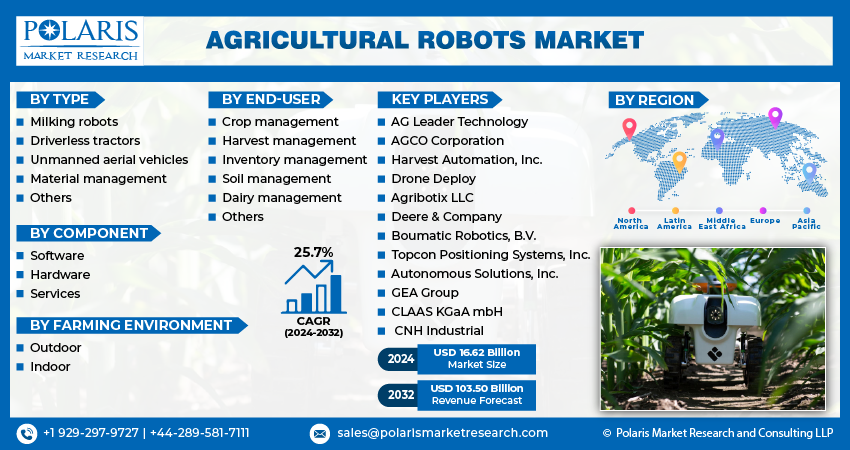Market Overview
Global Agricultural Robots Market size and share is currently valued at USD 13.26 billion in 2023 and is anticipated to generate an estimated revenue of USD 103.50 billion by 2032, according to the latest study by Polaris Market Research. Besides, the report notes that the market exhibits a robust 25.7% Compound Annual Growth Rate (CAGR) over the forecasted timeframe, 2024 – 2032
The shift toward precision farming—a farming management concept based on observing, measuring, and responding to inter- and intra-field variability in crops—has played a pivotal role in the accelerated adoption of agricultural robotics. Farmers are now leveraging drones, AI-powered sensors, and autonomous machinery to optimize resource usage and improve yields.
Key Market Growth Drivers
- Rising Labor Costs and Scarcity of Farm Workers
One of the most pressing challenges faced by the agricultural industry globally is the shortage of skilled labor. As younger generations migrate toward urban jobs and aging populations retreat from physically intensive farm work, the labor gap has widened. Agricultural robots offer a solution to this growing issue by taking over repetitive and strenuous tasks, ensuring productivity is maintained or even enhanced.
- Adoption of Precision Farming Technologies
The demand for precision farming tools has surged due to their ability to increase productivity while minimizing environmental impact. Agricultural robots equipped with advanced sensors and AI algorithms allow farmers to collect real-time data on soil health, crop conditions, and weather patterns. This enables data-driven decision-making, leading to more efficient farming practices and reduced waste.
- Technological Advancements in Robotics and AI
Recent innovations in artificial intelligence, machine learning, computer vision, and sensor technology have significantly enhanced the capabilities of agribots. Autonomous tractors are now able to navigate fields with high accuracy, drones can survey hundreds of acres in minutes, and robotic harvesters are capable of identifying ripe produce and picking it delicately, reducing spoilage.
- Demand for Sustainable Agriculture
With climate change and resource scarcity gaining global attention, sustainability has become a key concern in agriculture. Robotic systems reduce the use of chemical inputs through targeted application, lower carbon emissions by optimizing machinery routes, and minimize water usage through intelligent irrigation systems. These capabilities align well with growing environmental regulations and the need for responsible farming practices.
- Government Support and Subsidies
Several governments are actively supporting the integration of automation in agriculture through subsidies, grants, and pilot programs. Initiatives aimed at promoting smart farming technologies are boosting confidence among farmers and encouraging them to invest in robotics solutions.
Browse Full Report:
https://www.polarismarketresearch.com/industry-analysis/agricultural-robots-market
Market Challenges
Despite the positive outlook, the agricultural robots market faces several challenges:
High Initial Investment
One of the major hurdles for widespread adoption is the high upfront cost of agricultural robots. Small and medium-scale farmers, especially in developing countries, may find it financially burdensome to implement such advanced technologies without government assistance or financing solutions.
Limited Technical Knowledge
The deployment and maintenance of agricultural robots require a certain level of technical expertise. In regions where digital literacy is low or technical training is limited, the adoption rate tends to lag.
Interoperability and Standardization
Agricultural robots often come from different manufacturers and are designed for specific crops or tasks. The lack of interoperability and industry-wide standards can make it difficult for farmers to integrate multiple robotic solutions into a cohesive system.
Harsh Field Conditions
Farms present unpredictable working conditions, such as uneven terrain, weather changes, and biological variables. Ensuring consistent performance and durability of robots in these environments remains a technical challenge.
Regional Analysis
North America
North America holds a dominant share in the agricultural robots market, driven by early adoption of technology, strong infrastructure, and significant investments in agricultural innovation. The U.S. is at the forefront, with widespread use of autonomous tractors and drone-based crop monitoring systems.
Europe
Europe follows closely, bolstered by strict environmental regulations and a strong emphasis on sustainable agriculture. Countries like the Netherlands, Germany, and France are investing heavily in smart farming technologies. The European Union’s Common Agricultural Policy (CAP) also provides financial support for technological advancements.
Asia-Pacific
The Asia-Pacific region is expected to witness the fastest growth during the forecast period, especially in countries such as China, Japan, and India. The region’s large agricultural base, increasing mechanization, and government-driven digitization initiatives are fostering market expansion. Japan, in particular, is a leader in robotic harvesters, catering to its aging farming population.
Latin America
Latin America is gradually embracing agricultural robotics, particularly in Brazil and Argentina, where large-scale farming operations are more common. Investments in automation are being driven by the need to increase export competitiveness and reduce production costs.
Middle East & Africa
Though still in the nascent stages, countries in the Middle East and Africa are beginning to explore the use of agricultural robots, particularly in greenhouse and irrigation management. Water conservation and food security are key motivators in this region.
Key Companies in the Market
Several companies are actively contributing to the growth and innovation of the agricultural robots market. While each focuses on different product categories, they share a common goal—enhancing agricultural productivity and sustainability.
- AG Leader Technology
- AGCO Corporation
- Harvest Automation, Inc.
- Drone Deploy
- Agribotix LLC
- Deere & Company
- Boumatic Robotics, B.V.
- Topcon Positioning Systems, Inc.
- Autonomous Solutions, Inc.
- GEA Group
- CLAAS KGaA mbH
- CNH Industrial
Conclusion
The agricultural robots market is poised for transformational growth, ushering in a new era of automation and efficiency in farming. As the world grapples with labor shortages, climate change, and the demand for higher agricultural output, robotic solutions are no longer a futuristic concept—they are becoming a necessity.
More Trending Latest Reports By Polaris Market Research:
Radio-Frequency Identification (RFID) Market
Smart Bags Market: A Convenient and Secure Way of Contemporary Traveling

